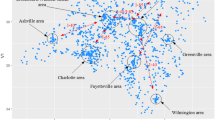Abstract
Accident taxonomy or classification can be used to direct the attention of policymakers to specific concerns in traffic safety, and can subsequently bring about effective regulatory change. Despite the widespread usage of accident taxonomy for general motor vehicle crashes, its use for analyzing bus crashes is limited. We apply a two-stage clustering-based approach based on self-organizing maps followed by neural gas clustering to construct a data-driven taxonomy of bus crashes. Using the 2005–2015 data from general estimates system, we identify four clusters and expose the qualitative traits that characterize four distinct types of bus crash. Our analysis suggests that cluster characteristics are largely stable over time. Consequently, we make targeted policy recommendations for each of the four subtypes of bus crash.








Similar content being viewed by others
References
Amjadi R, Martinez W (2021) The 2016 data challenge of the American Statistical Association. Computational Statistics
Analysis Division, Federal Motor Carrier Safety Administration, United States Department of Transportation (2014) Large Truck and Bus Crash Facts 2014. Technical report. https://www.fmcsa.dot.gov/safety/data-and-statistics/large-truck-and-bus-crash-facts-2014. accessed 2016-09-01
Dimitriadou E (2015) cclust: Convex Clustering Methods and Clustering Indexes. R package version 0.6-20. https://cran.r-project.org/web/packages/cclust/index.html. Accessed 2016-09-01
Friedman J, Hastie T, Tibshirani R (2001) The elements of statistical learning. Springer series in statistics. Springer, New York
Kohonen T (1982) Self-organized formation of topologically correct feature maps. Biol Cybern 43(1):59–69
Kohonen T (1990) The self-organizing map. Proc IEEE 78(9):1464–1480
MacQueen J (1967) Some methods for classification and analysis of multivariate observations. In: Proceedings of the fifth Berkeley symposium on mathematical statistics and probability, volume 1: statistics, pp 281–297
Martinetz T, Schulten K (1991) A “neural-gas” network learns topologies. In: Kohonen T, Mäkisara K, Simula O, Kangas J (eds) Artificial neural networks. Elsevier, North-Holland, pp 397–402
National Highway Traffic Safety Administration (2009–2017) GES analytical user’s manual. https://crashstats.nhtsa.dot.gov/#/PublicationList/107. Accessed 2016-09-01
Prato CG, Kaplan S (2013) Bus crash patterns in the United States: a clustering approach based on self-organizing maps. In: WCTR 2013: 13th world conference on transportation research
R Core Team (2016) R: a language and environment for statistical computing. R Foundation for Statistical Computing, Vienna, Austria. https://www.R-project.org/. Accessed 2016-09-01
Vesanto J, Alhoniemi E (2000) Clustering of the self-organizing map. IEEE Trans Neural Netw 11(3):586–600
Wehrens R, Buydens L (2007) Self- and super-organizing maps in R: the Kohonen package. J Stat Softw 21(5):1–19
Author information
Authors and Affiliations
Corresponding author
Additional information
Publisher's Note
Springer Nature remains neutral with regard to jurisdictional claims in published maps and institutional affiliations.
Rights and permissions
About this article
Cite this article
Roy, D., Deshpande, V. & Linder, M.H. A cluster-based taxonomy of bus crashes in the United States. Comput Stat 36, 1621–1638 (2021). https://doi.org/10.1007/s00180-021-01073-8
Received:
Accepted:
Published:
Issue Date:
DOI: https://doi.org/10.1007/s00180-021-01073-8




